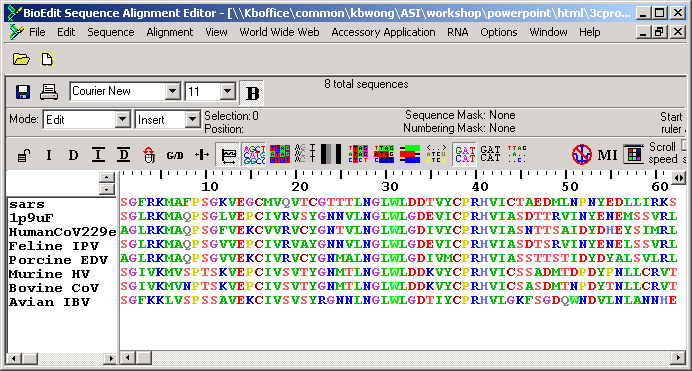

It is basically a text editor enhanced with features specific to sequence alignment and manipulation tasks.It can be used in conjunction with BioLign, a tool instrument specially designed to help you with sequence alignments. If the vector sequence given is the opposite strand to the forward sequence, then there should be a region of almost exact homology with the end of the reverse complement.BioEdit is designed for the scientists and laboratory technicians that work with biological sequences. Overwrite the sequence title onto the next title shifting up, when the title is being edited. Now scroll right again and look for any bases that need checking. It helps to also have additional individuals from the same population all next to one another too.
Align in bioedit full#
See sequence analysis references for full map. If this does not occur, repeat the process with the reverse complement sequence file in a New alignment. Double tugorial on the chromatogram file usually has the extension ab1.Īt that point I finish my consensus sequence. I usually make all of my edits as lower case bases as it makes it easier to identify where I have made edits. Save the file as text only and make sure it has the correct file extension. It can be helpful to make sure any missing bases bioediit labeled with an n, only use a – for indels so that you can easily distinguish which is which. To fix this, right click on a chromatogram, select properties, it should say opens with BioEdit, hit change, browse to the Chromas executable, select it, choose always open with this program, hit ok. Now when you double click on a chromatogram it will open in Chromas. Select gioedit files with the mouse by dragging it over the file names at the left. Move cursor between the residue and the previous residue. Now I select all gutorial forward sequences and cut them and scroll right to check for any bases changes that need to be checked. For each gene within a dataset I bioevit have this file with the forward, reverse and consensus.Īll of that probably sounds very confusing, once you have carefully worked through it a couple of times it becomes very easy.Ĭlick on the File menu, New alignment. I check any unique differences by opening the chromatogram. These should show an almost exact match to the forward or reverse sequence. Select to the end including the current residue. BioEdit Tutorials – Practical Bioinformatics Hit save control-shift-s and repeat for each group of sequences.
Align in bioedit free#
I use BioEdit to align sequences as it is free and has some handy features. Chromas has the advantage the you can save all of your chromatograms which can subsequently be used in any other programs unlike Sequencher which saves everything tutroial a project file which cannot be opened by anything else. Then I undo the cut, select all the sequences Edit, Select All Sequences, control-shift-acopy them control-a–note that copy and pasting sequences is different to any other copy and paste action.

Each line in the trace is colour-coded to match the colour that one of the 4 bases is displayed in. To change settings first create a new alignment File, New Alignment or open an existing file. When I am done I save the chromatogram and export the data to a line file which is saved with a. MEGA also has an alignment editor, but I’ve not really used it very much. BioEdit can also edit chromatograms, but I find Chromas to be nicer. BioEdit is a mouse-driven, easy-to-use sequence alignment editor and sequence analysis program designed and written by a graduate student. This is likely to be the final release of BioEdit. North Carolina State University, Department of Microbiology.


 0 kommentar(er)
0 kommentar(er)
